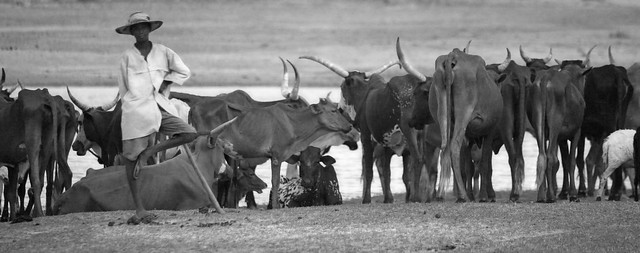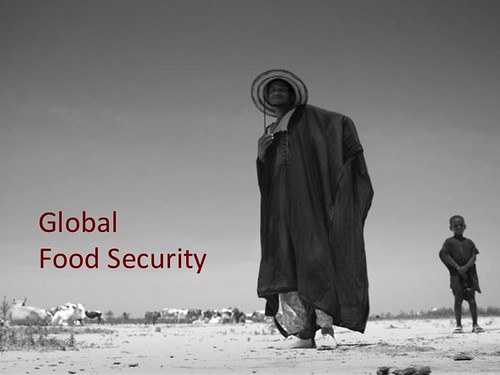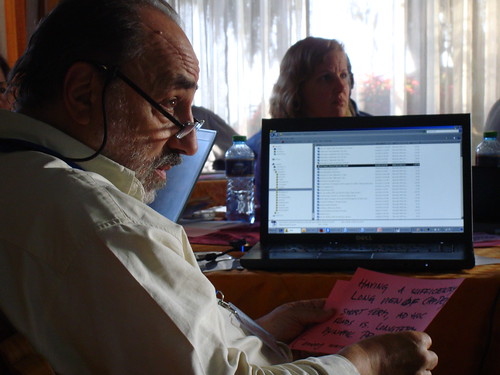
Javier Ekboir, of the Institutional Learning and Change (ILAC) initiative, hosted by Bioversity International, and Nicole Lefore, of the International Water Management Institute IWMI), listen to proceedings of a CGIAR Consortium Workshop, ‘Towards a CGIAR Strategy on Capacity Development’, hosted by ILRI, in Nairobi this week (21–25 Oct 2013); most of the participants are responsible for capacity development or are researchers working in the areas of social learning, innovation or partnership (photo credit: ILRI/Susan MacMillan).
Most of those in or around CGIAR institutions for any length of time will have heard, likely absorbed and sometimes themselves promulgated two hoary notions. The first is that CGIAR work is among the world’s ‘best kept secrets’. The second is that a well-trained cadre of developing-country agricultural scientists is among CGIAR’s biggest, if inadequately assessed, impacts. (These views are occasionally conflated, as in ‘The amount and quality of CGIAR training in agricultural sciences over the last four decades is among its best-kept secrets’.)
A group of CGIAR staff meeting in Nairobi this week is dusting off these views (convictions?) in an attempt to reframe what was once known as ‘training’, later transformed into ‘institutional learning’ or ‘capacity development’ (or one of its several [elegant] variations such as ‘capacity strengthening’ or ‘capacity building’), and reposition it at the centre rather than the periphery of CGIAR business.
The goal of the workshop is for CGIAR research centres, programs and partners to identify optimal ways to increase capacity in agricultural research for development work, particularly in achieving the four CGIAR system-level (and development-oriented) outcomes:
- reduced rural poverty
- increased food security
- improved nutrition and health
- more sustainable management of natural resources
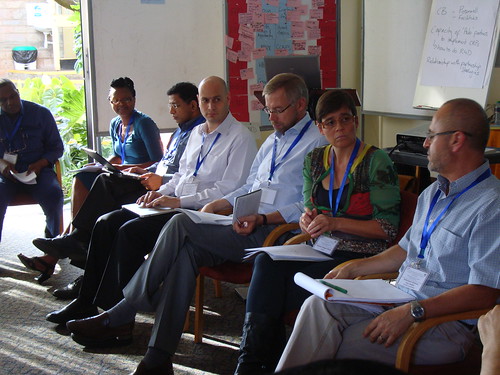
Left to right: Zoumana Bamba (IITA), Joyce Maru (ILRI), Suresh Babu (IFPRI), Iddo Dror (ILRI), Per Rudebjer (Bioversity), Simone Staiger-Rivas (CIAT), Luis Solórzano (Consortium Office) are members of a panel at the CGIAR Capacity Development Workshop in 2013 (photo credit: ILRI/Susan MacMillan).
How this work has found itself off-centre (and how far off-centre) in CGIAR institutions and research programs was briefly reviewed in a panel discussion Monday (21 Oct 2013), the first of five days of a workshop on CGIAR Capacity Development organized and hosted by the International Livestock Research Institute (ILRI) at its Nairobi headquarters.
The panel session, led by Simone Staiger-Rivas, head of knowledge management and capacity development at the Colombia-based International Center for Tropical Agriculture (CIAT), comprised seven members who had contributed to a recently published discussion paper, Understanding capacity development experiences and lessons from the past, commissioned by Louis Solórzano, director of staff at the CGIAR Consortium, in France, for the purpose of helping to establish a new CGIAR strategy for capacity development.
Although capacity development at each of the 15 agricultural research centres that are members of CGIAR has had a distinctive trajectory, the following are some of the commonalities, as noted by Staiger-Rivas.
Throughout the 1970s and 1980s, when CGIAR centres had substantial core funding for training as well as research, many centres built strong training units. Those were among the ‘research support services’ that suffered most from reductions in CGIAR core funding beginning in the 1990s and the restructuring that followed in the next decade. Increasingly in this period, training was embedded directly into research programs.
Starting in the 1990s, a major shift in the amount and type of donor funding to CGIAR had a massive impact on how training was organized, funded and implemented across the system. The decline of core funding led to a reduction or elimination in most Centers of training as a stand-alone activity. The Centers relied on the ability of their scientists to attract funding for training within their research projects. Training units were weakened, with few staff qualified in training, pedagogy or adult education. The responsibility for training itself was often passed on to national or regional partners, with mixed results. On the positive side, this decentralization connected the Centers more directly with field activities, which allowed the Centers to involve extension, farmer, and market capacities (Staiger-Rivas et al. 2013).
In the following decade, as CGIAR centres grew into ‘middle age’ (most are now between 40 and 50 years old), what is now generally called ‘capacity development’ work widened its ambitions to train individuals and groups to include making impacts at the level of institutions and innovations.
The trend towards results-based management in CGIAR includes a perception of [capacity development] as means to enable social learning and innovation and promote sustainable development as a collective achievement (Staiger-Rivas et al. 2013).
Here is how this evolution is described by a group at a former CGIAR centre, the International Service for National Agricultural Research (ISNAR), which first brought ‘innovation systems thinking’ to the CGIAR table in the early 2000s.
‘If agricultural research organizations are to be more successful in reducing poverty and increasing the sustainability of agricultural production systems, they must become less isolated, more interconnected and more responsive. In so doing, they must transform themselves into learning organizations, more in touch with field realities and better able to learn and to change. . . .
‘[I]f agricultural research centers are to cope with growing complexity and seize opportunities as they arise, they need not merely new approaches to research organization or practice, but more flexible and adaptive institutional arrangements. . . . [T]he CGIAR must change from a supply-led model of centers of excellence to a more responsive mode of operation in which partnership and client orientation are core principles. . . .
‘If scientists and CGIAR Centers are to contribute meaningfully to innovation, they must become continuous learners, evolving and adapting all the time. . . .
‘CG Centers must attempt to become “learning organizations”—organizations that are open and flexible, that identify and recognize both successes and failures as opportunities to learn and improve, and that build relationships with the many and varied participants involved in agricultural development’ (Watts et al. 2007).
The next panel member to speak, Per Rudebjer, of Bioversity International, in Rome, said that training is essential mechanism for partnership. ‘CGIAR has trained some 80,000 people, in formal as well as informal ways. With the funding reductions in the 1990s, centres started training fewer people and offering shorter training courses. In the next decade, we began to take on organizational as well as individual learning. Now we are seeing another change: training in support of outcome delivery.
Training is necessary but not sufficient for capacity development.
Iddo Dror (ILRI), head of ILRI’s capacity development unit, in Nairobi, spoke on the current state of capacity development in CGIAR. The capacity development strategy is not as mature as some of the other cross-cutting work in CGIAR research programs, Dror said.
Although lots of the things we’re grappling with were foreseen, Dror said, they still have little ‘meat’ on them. While CGIAR’s Strategic Results Framework anticipates an expansion in capacity development activities, the role and modalities of capacity development in the new CGIAR structure has not yet been fully fleshed out.
What’s needed now, said Dror, is capacity for applied or downstream agricultural research for development.
We need a new framework, one that helps us move innovations from the lab to the farmers, one that changes what we do as well as how we do it.
Dror then briefly reviewed what Purvi Mehta-Bhatt and Jan Beniest found in their 2011 report as shortcomings in a comprehensive review of capacity development for the CGIAR research programs. These include the following.
- Capacity development plans are extremely ambitious but have insufficient focus.
- Most capacity development plans make explicit mention of other cross-cutting kinds of work and expertise—in gender, youth, communications—but it remains unclear as to how these various work agendas interact.
- CGIAR research programs tend to provide ‘laundry lists’ of capacity development-related activities but are unclear about how these will be coordinated. Some community of practice or other ways of aligning this work is needed.
We’re also grappling with different views of capacity development, Dror said. We have 1960s views, 1980s views, 21st century views, all of them working alongside each other, but not in tandem.
As capacity development practitioners, we haven’t kept up the pace. Our new capacity development approaches have huge implications for how we do research; this is not yet understood by all of us.
We need to look at how we can better embed capacity development in agricultural research for development, at how we can help sharpen, deepen and widen the impact pathways from research products to intermediate development outcomes to system-level outcomes.
The outcome orientation of CGIAR puts new demands on capacity development for partners who will be instrumental in scaling up/out research outputs (Staiger-Rivas et al. 2013)
Zoumana Bamba, of the International Institute of Tropical Agriculture (IITA), spoke on institutional capacity development and the new need for new skill sets among researchers.
We need to research how to up-scale and out-scale our outputs, Bamba said. We don’t know enough about the mechanisms of those processes.
Suresh Babu, of the International Food Policy Research Institute (IFPRI), spoke on monitoring and evaluation.
We need quantitative and qualitative indicators, Babu said. IFPRI implemented a monitoring system just last year.
If CGIAR is going to be serious about capacity development, it has to be serious about putting in place a monitoring and evaluation system for capacity development.
Babu noted the long struggle in capacity development work to measure its impacts, reminding participants that what you cannot measure you cannot manage. The big changes and reduced funding for CGIAR in the 1990s led to piecemeal approaches, he said. The idea that capacity development was an ‘impact-making’ activity fell away. In some centres, capacity development work was put under the care of new knowledge management teams; in others, it became part of communications; in still others, it ceased as a discrete function altogether.
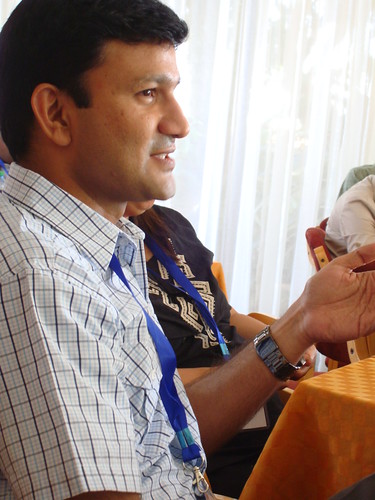
Dileepkumar Guntuku, of the International Crops Research Institute for the Semi-Arid Tropics (ICRISAT) (photo credit: ILRI/Susan MacMillan).
Note on capacity development at the International Service for National Agricultural Research (ISNAR)
In their recent (2012) book Capacity Building for Agricultural Research for Development: Lessons from Practice in Papua New Guinea,”Adiel N. Mbabu and Andy Hall describe ISNAR as follows.
ISNAR was unique in the CGIAR system in that unlike all the other international centres it had an explicit capacity building agenda rather than research (although as will be related, this eroded over time). The institute was also unique in that it was staffed by an eclectic set of professionals: economists, sociologists, human resource specialists, organisational development specialists, research management specialists, evaluators and policy researchers. As a result of this, it drew on professional perspectives outside of agricultural research. Many of these perspectives were already using systems ideas, particularly in the fields of evaluation, and organisational development. So, for example, ISNAR’s capacity development activities were already making use of learning and evaluation as ways of upgrading organisational performance (see Horton et al., 2003). The organisation was also unique in that it was focusing on retooling professional skills of agricultural researchers and research managers to help them cope with the changing context of agricultural development. This led to the rolling development of a series of capacity development modules aimed at helping research staff learn their way into new roles and ways of working” (Staiger-Rivas et al. 2013).



















